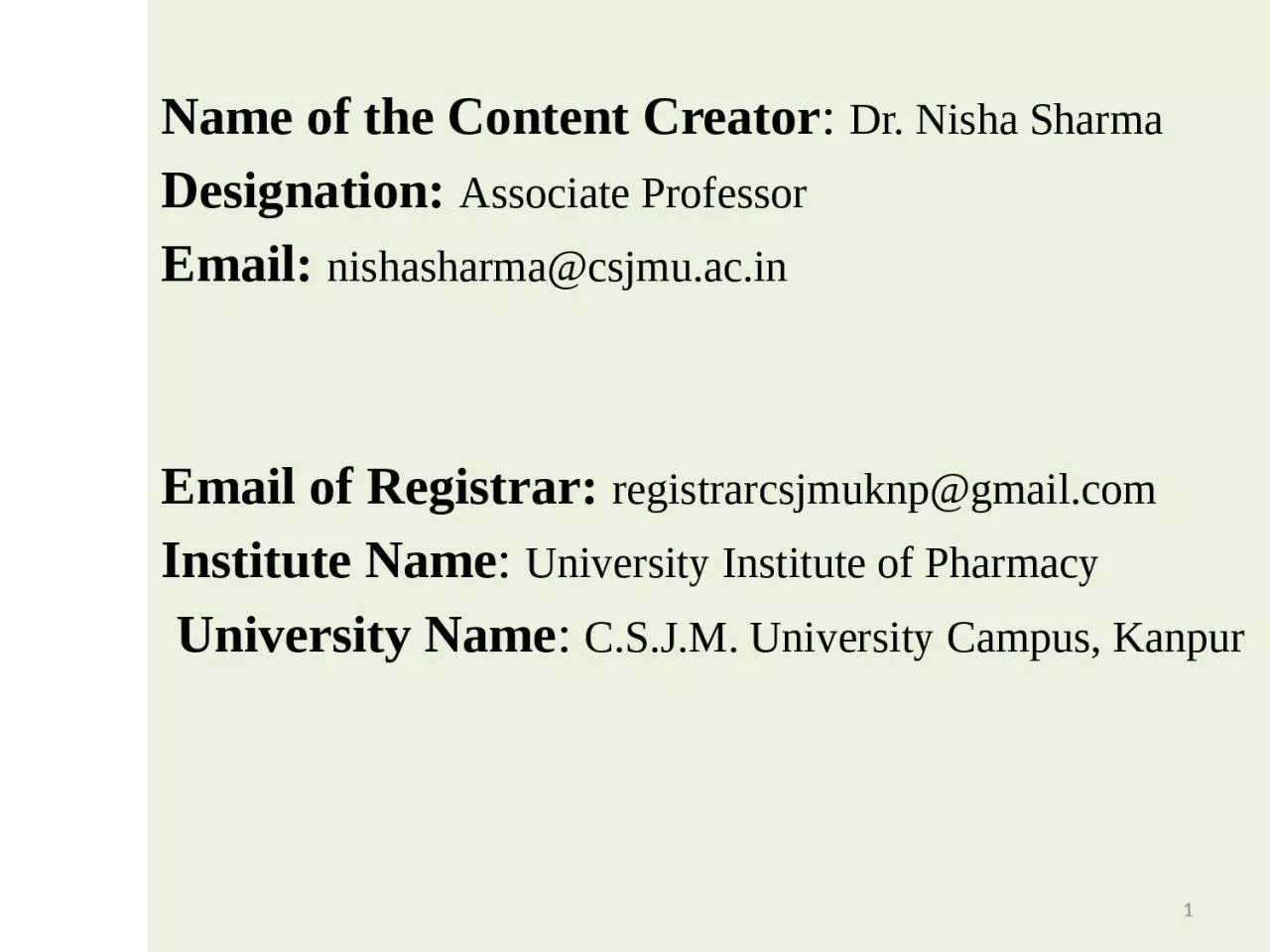

Dr Nisha Sharma Designation Associate Professor Email nishasharmacsjmuacin Email of Registrar registrarcsjmuknpgmailcom Institute Name University Institute of Pharmacy ID: 932638
Download Presentation The PPT/PDF document "Name of the Content Creator" is the property of its rightful owner. Permission is granted to download and print the materials on this web site for personal, non-commercial use only, and to display it on your personal computer provided you do not modify the materials and that you retain all copyright notices contained in the materials. By downloading content from our website, you accept the terms of this agreement.
Slide1
Name of the Content Creator: Dr. Nisha SharmaDesignation: Associate Professor Email: nishasharma@csjmu.ac.inEmail of Registrar: registrarcsjmuknp@gmail.comInstitute Name: University Institute of PharmacyUniversity Name: C.S.J.M. University Campus, Kanpur
1
Slide2B.PHARM. 4th SEMESTER BP405 T. PHARMACOGNOSY AND PHYTOCHEMISTRY II (Theory)UNIT-IVINTRODUCTION TO SECONDARY METABOLITESVOLATILE OILSDr. Nisha
Sharma
Associate Professor (Former Head)
University Institute of PharmacyC.S.J.M. University, Kanpurnishasharma@csjmu.ac.in
2
Slide3Volatile OilsThese are Odorous volatile principles of plant & animal source, they evaporate if exposed to air at ordinary temperature, hence known as volatile or etheral oils.Essence of active constituents of the plant - known as essential oils.
Slide4PROPERTIES OF VOLATILE OILSPhysical PropertiesVolatile in natureHave characteristic odor & flavorSolubility: Immiscible in water, fairly sol. in alcohol, freely sol. in ether, CHCl3Lighter than water, exception: clove oil is heavierMost of them are colorless liq.Have ↑ Refractive index ex. Cinnamon oil: 1.562-1.582Most of them are optically active Cumin oil: +4 to +8Chemical PropertiesThey are derived from terpeneMostly mono &
sesquiterpenes
& their oxygenated derivatives i.e.
terpenoids 2.
Terpenes
are built of Isoprene unit (C
5
H
8
)
3. They are open chain or cyclic unsaturated compound, have 1 or more double bonds4. Thermal decomposition: Isoprene as one of the product5. Have olefinic bond, easily oxidised by all oxidising agents6. Terpenoids undergo addition reaction with H2 & halogen acids.
Slide5ClassificationVolatile oils are classified on the basis of functional groups present GroupsDrugsHydrocarbonsTurpentine oilAlcoholsPeppermint, sandalwood oilAldehydesLemongrass, cinnamon, cassia, saffron KetonesCamphor, caraway, dill, jatamansi, fennelPhenolsClove, ajowan, tulsiPhenolic ethers
Nutmeg
Oxides
Eucalyptus, cardamom, chenopodium oilEstersValerian, rosemary, garlic, gaultheria oil
Slide6CLASSIFICATION OF VOLATILE OILSNCLASSSTRUCTURECONSTITUENTSNAME OF DRUG1AB Hydrocarbon volatile oilMonocyclicBicyclic
Limonene
α-
Pinene
Cardamon
Coriander oil
2
Esters of Volatile oil
Methyl
Salicylate
Winter green oil3Ether Volatile oilAnetholeFennel
Anise
Slide7CLASSIFICATION OF VOLATILE OILSNCLASSSTRUCTURECONSTITUENTSNAME OF DRUG4Alcohol Volatile oila. Acyclic
Citronellol
Lemon Grass
b. Monocyclic
Menthol
Peppermint
5
Aldehyde
volatile oil
Citral
Lemon
Slide8CLASSIFICATION OF VOLATILE OILSNCLASSSTRUCTURECONSTITUENTSNAME OF DRUG6Ketone Volatile OilCamphor
Carvone
Camphor
Caraway
7
Oxides Volatile oils
Cineole
Eucalyptus Oil
8
Phenol Volatile oil
EugenolThymol Clove
Mint
Slide9TERPENOIDSGroup of naturally occurring compoundsTerpenes or Terpenoids are volatile substances which give plants and flowers their fragrance.Term ‘terpene’ was given to the compounds isolated from terpentine, a volatile liquid isolated from pine trees. Terpenoids are the hydrocarbons of plant origin of the general formula (C5H8)n as well as their oxygenated, hydrogenated, and dehydrogenated derivatives. The simpler mono and
sesquiterpenes
is the chief constituent of the essential oils obtained from sap and tissues of certain plant and trees.
The di- and
triterpenoids
are not steam volatile. They are obtained from plant and tree gums and resins.
Tertraterpenoids
form a separate group of compounds called ‘
Carotenoids
’.
The term ‘terpene’ was originally used to describe a mixture of isomeric hydrocarbons with molecular formula C10H16 occurring in the essential oils. But more general term is ‘terpenoids’, which includes hydrocarbons and their oxygenated derivatives.
Slide10Classification Terpenoidsclassified on the basis of number of carbon atoms present in the structure.Number of carbon atomsValue of nClassFormula102MonoterpenoidsC
10
H
16153SesquiterpenoidsC15H24
20
4
Diterpenoids
C
20
H
32255SesterpenoidsC25H40306TriterpenoidsC30H48408TetraterpenoidsC40H64˃40˃8Polyterpenoids(C5H8)n
Slide11Identification TestsNatural drugs containing volatile oils can be tested by following chemical tests: Thin section of drug + alcoholic solution of Sudan III → red color → confirm volatile oils.Thin section of drug + tincture of alkana → red colour → presence of volatile oilsVolatile oil smeared on thin paper→ Temporary stain → disappears on exposureSpecific test for camphor: natural camphor +vanillin + H2SO4 (1:100)→Yellow → changes to red, violet and finally blue (series of color changes)
Slide12REFERENCESPharmacognosy, C.K. Kokate, A.P. Purohit, S.B. Gokhale, 54th Ed. 2017, Nirali Publication, New DelhiTrease and Evans Pharmacognosy, W.C. Evans, 15th Ed. Elsevier, 2002.